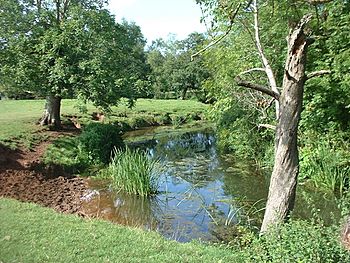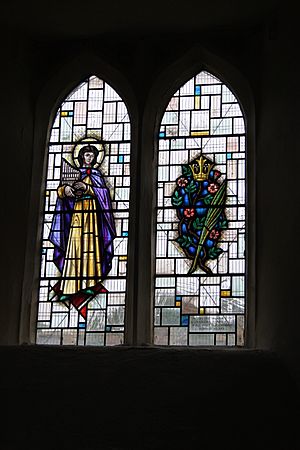River Chew facts for kids
Quick facts for kids River Chew |
|
|---|---|

River Chew between Stanton Drew and Pensford
|
|

Topographical map of the Chew Valley
|
|
| Country | England |
| County | Somerset |
| District | Chew Valley |
| Physical characteristics | |
| Main source | Chewton Mendip Mendip Hills, Somerset, England 305 m (1,001 ft) 51°16′34″N 2°34′42″W / 51.27611°N 2.57833°W |
| River mouth | River Avon, Bristol Keynsham, Somerset, England 10 m (33 ft) 51°25′29″N 2°30′26″W / 51.42472°N 2.50722°W |
| Length | 27 km (17 mi) |
| Basin features | |
| Basin size | 145 km2 (56 sq mi) |
| Tributaries |
|
The River Chew is a small river in England. It flows for about 27 kilometers (17 miles) through the beautiful North Somerset countryside. This river helps create the lovely Chew Valley. Eventually, it joins with the larger River Avon.
The River Chew starts from a spring near Chewton Mendip. It then flows northwest through several villages and towns. These include Litton, Chew Valley Lake, Chew Stoke, Chew Magna, and Stanton Drew. The river also goes under the A37 at Pensford. It continues through Publow, Woollard, Compton Dando, and Chewton Keynsham. Finally, it meets the River Avon in Keynsham. A walking path called the Two Rivers Way follows the Chew for much of its journey. This path is also part of the longer Monarch's Way.
Contents
What Does "Chew" Mean?
The name "Chew" has very old roots. It comes from the Celtic language. It might be related to the River Chwefru, which means "the moving, gushing water." Old names for places along the river, like Estoca (for Chew Stoke) and Chiu (for Chew Magna), show this ancient origin.
There are a few ideas about what "Chew" exactly means:
- Some think it means "winding water." The "ew" part could be like the French word eau, meaning "water."
- The word chewer is an old local word for a "narrow passage."
- Chare is an Old English word for "turning."
Another idea is that the name comes from the Welsh word cyw. This word means "the young of an animal" or "chicken." So, Afon Cyw could have meant "the river of the chickens."
Other theories suggest the name comes from:
- An Old English word cēo, meaning "fish gill." This could refer to a ravine or narrow valley.
- A nickname from the Middle English word chowe, meaning "chough." A chough is a bird similar to a crow or jackdaw. These birds were known for being noisy and stealing things.
- Some even think the river is named after Tiw, a Viking war god.
How the River Chew Flows
The way the River Chew flows today probably formed after the last ice age. Before that, the river might have flowed differently. It may have followed the path of the Congresbury Yeo river to the Bristol Channel. But ice blocking the Bristol Channel likely changed its direction. This made the Chew flow north instead of west through Compton Martin to join the Avon.
Roman Times and the River
In Roman times, lead was mined in the Mendip Hills. This lead was shaped into large blocks called "pigs." These lead blocks were brought to the River Chew. From there, they were transported to Sea Mills on the River Avon. This allowed the lead to be shipped overseas.
The Great Flood of 1968

In 1968, a very big flood hit the Chew Valley. This flood caused serious damage to many towns and villages along the river. For example, the bridge at Pensford was completely swept away by the powerful water.
Fishing in the River Chew
To help fish move around, special "fish ladders" have been built. These ladders are at three weirs (small dams) in Keynsham and Chewton Keynsham. They allow fish to swim upstream past the weirs.
The Keynsham Angling Club owns the fishing rights for parts of the river. These include the Millground and Chewton sections. The Mill Ground area covers six fields on the left bank of the river. This stretch goes from Chewton Place at Chewton Keynsham to the Albert Mill in Keynsham.
The River Chew is home to many different types of fish. You can find chub, roach, European perch, rudd, gudgeon, and dace. There are also grayling, trout, and eel.
Gallery




